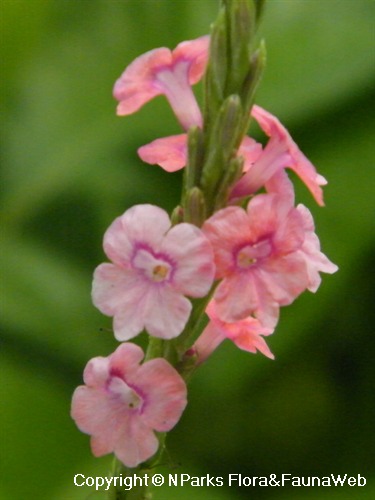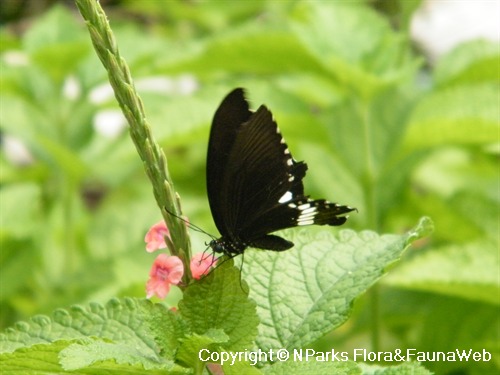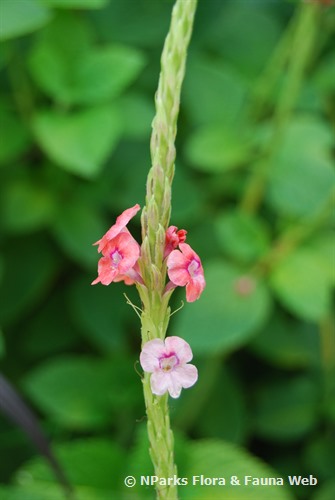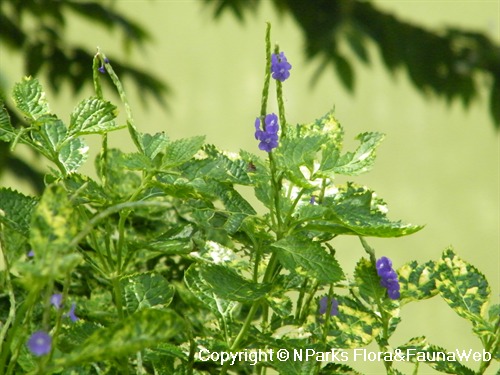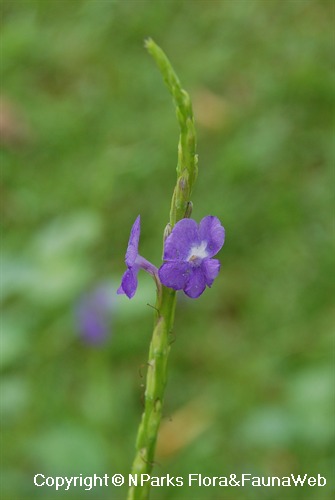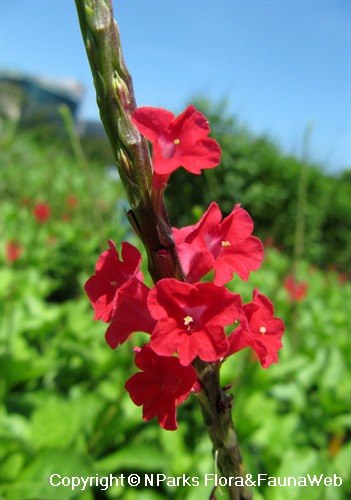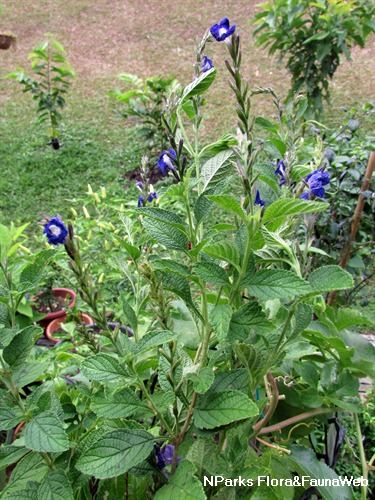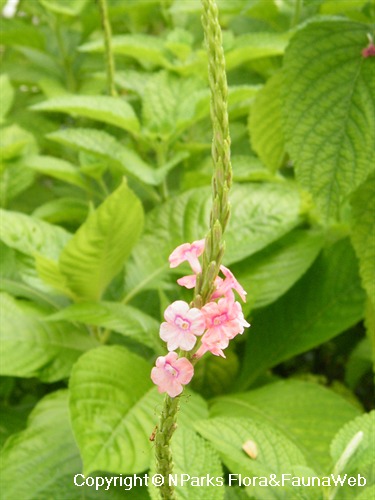
Back
Stachytarpheta mutabilis (Jacq.) Vahl
| Family Name: | Verbenaceae |
| Synonyms: | Verbena mutabilis |
| Common Name: | Pink Snakeweed, Changeable Velvetberry, Red Porterweed, Pink Snakeweed, Pink False Vervain, Pink Rat Tail |
Name
Classifications and Characteristics
| Plant Division | Angiosperms (Flowering Seed Plants) (Dicotyledon) |
|---|---|
| Plant Growth Form | Shrub |
| Lifespan (in Singapore) | Perennial |
| Mode of Nutrition | Autotrophic |
| Plant Shape | Rounded |
| Maximum Height | 1.2 m to 1.8 m |
Biogeography
| Native Distribution | Mexico, Caribbean, South America |
|---|---|
| Native Habitat | Terrestrial (Disturbed Area / Open Ground) |
| Preferred Climate Zone | Tropical |
| Local Conservation Status | Non-native (Spontaneous (Casual)) |
Description and Ethnobotany
| Growth Form | A woody shrub with long prominent spike inflorescences. |
|---|---|
| Foliage | Opposite leaves are elliptic to ovate (5 - 12 cm long, 2.5 - 6 cm wide). The leaf margin is serrate or crenate, having teeth that point towards the leaf tip. Leaves are deeply veined, giving the upper surface a rugose, uneven texture. The lower surface is covered in soft, short hairs. Leaves are acute (pointed, but indistinct tip) or acuminate (thin, distinct pointed tip). |
| Stems | Woody stem has light grey bark. Young stems are 4-sided and covered in soft, short hairs. |
| Flowers | Salverform flowers have a white throat and 5 lobes (1.3 - 1.8 cm long, 1 cm wide). Initially bright red or magenta, they gradually become light pink over a few days. They are arranged on a 10 - 60 cm long terminal spike inflorescence (an inflorescence at the stem tip which has stalkless flowers held along one main axis). About 5 - 7 flowers are open at a time on the spike. They last for several days before being replaced by a new set. The inflorescence blooms in this manner for months. |
| Fruit | Dry, indehiscent fruit is known as a nutlet, a one-seeded small nutlike fruit. It is formed by the fragmentation of a multi-sectioned fruit into single-seeded pieces. |
| Habitat | Found in disturbed areas, such as along roadsides or in pastures that have been overgrazed. Also occurs along creeks, It is considered an invasive species in Australia, Hawaii, and the Fiji Islands. |
| Cultivation | Plant in well-drained, fertile soil enriched with compost. Space individuals 1.2 - 1.8 m apart. To prevent excessive establishment of new seedlings, remove spent flowers before they set seed. |
| Etymology | The genus "Stachytarpheta" comes from the Greek words for spike ("stachys") and thick ("tarphys"). It refers to the spike inflorescence found in many species of this genus. The species epithet "mutabilis" means that it has the ability to change. This refers to how the flowers change colour from reddish to pink over time. |
Landscaping Features
| Landscaping | This species is planted as an ornamental shrub for its pinkish flowers. The flowers are interesting in that their colour gradually fades from reddish to light pink. This species is ideal for butterfly gardens as a nectar plant. Place it in the back to avoid obscuring smaller species. It may also be planted as a living fence or hedge. |
|---|---|
| Desirable Plant Features | Ornamental Flowers |
| Landscape Uses | General, Hedge / Screening, Container Planting |
| Thematic Landscaping | Butterfly Garden |
| Usage Hazard - Cons | Invasive / Potentially Invasive |
Fauna, Pollination and Dispersal
| Fauna Pollination Dispersal Associated Fauna | Butterfly-Attracting (Flower Nectar), Bee-Attracting |
|---|---|
| Pollination Method(s) | Biotic (Fauna) (Insects (Butterfly, Moth)) |
| Seed or Spore Dispersal | Abiotic, Biotic (Fauna) |
Plant Care and Propagation
| Light Preference | Full Sun |
|---|---|
| Water Preference | Moderate Water |
| Rootzone Tolerance | Fertile Loamy Soils, Well-Drained Soils |
| Maintenance Requirements | Moderate |
| Propagation Method | Seed, Stem Cutting (Softwood) |
| Propagation Method Remarks | Propagate by seed or softwood cuttings. To collect seeds for propagation, allow the seedhead to dry on the plant before harvesting the seeds. |
| Planting Distance | 1 to 1 |
Foliar
| Foliage Retention | Evergreen |
|---|---|
| Mature Foliage Colour(s) | Green |
| Mature Foliage Texture(s) | Raised / Sunken Veins |
| Prominent Young Flush Colour(s) | Green |
| Young Flush Texture(s) | Raised / Sunken Veins |
| Foliar Type | Simple / Unifoliate |
| Foliar Arrangement Along Stem | Opposite |
| Foliar Attachment to Stem | Petiolate |
| Foliar Shape(s) | Non-Palm Foliage (Ovate, Elliptical) |
| Foliar Venation | Pinnate / Net |
| Foliar Margin | Serrate / Toothed, Crenate |
| Foliar Apex - Tip | Acute, Acuminate |
| Foliar Base | Cuneate |
| Typical Foliar Area | Mesophyll ( 45cm2 - 182.25 cm2 ) |
Non - Foliar and Storage
| Bark Colour(s) | Light grey |
|---|---|
| Stem Type & Modification | Woody |
| Root Type | Underground (Tap Root) |
Floral (Angiosperm)
| Flower & Plant Sexuality | Bisexual Flowers |
| Flower Colour(s) | Pink, Red |
|---|---|
| Flower Grouping | Cluster / Inflorescence |
| Flower Location | Terminal |
| Flower Symmetry | Bilateral |
| Individual Flower Shape | Salverform |
| Flower Size - Remarks | floral tube is 1.3 - 1. 8 cm long |
| Inflorescence Type | Spike |
| Flower Transitional Changes | Colour |
| Flowering Period | Free-Flowering |
| Flowering Opening Time | Daytime |
| Flower Lifespan on Plant | Several Days |
| Flowering Habit | Polycarpic |
Fruit, Seed and Spore
| Fruit Classification | Simple Fruit |
|---|---|
| Fruit Type | Indehiscent Dry Fruit , Nut / Nutlet |
Image Repository
Others
| Master ID | 29417 |
|---|---|
| Species ID | 3726 |
| Flora Disclaimer | The information in this website has been compiled from reliable sources, such as reference works on medicinal plants. It is not a substitute for medical advice or treatment and NParks does not purport to provide any medical advice. Readers should always consult his/her physician before using or consuming a plant for medicinal purposes. |

